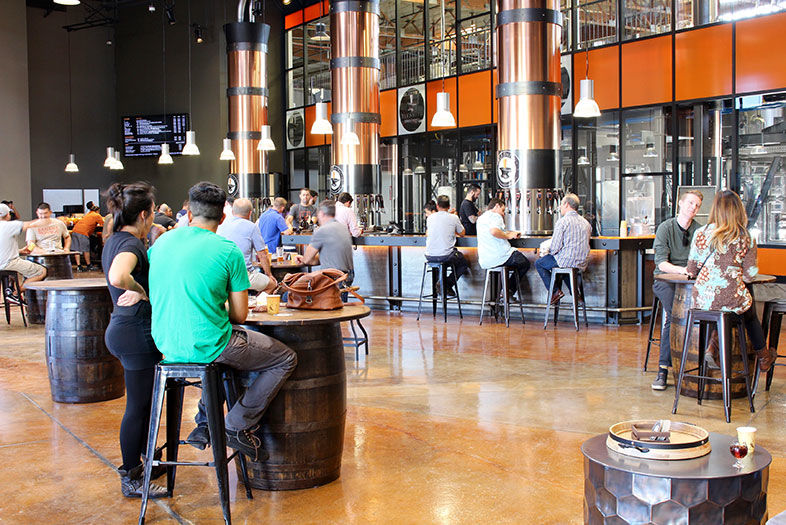Most breweries, like most businesses, grow incrementally. You watch them and (if they’re lucky) you can see them go from small, to medium, to large. AleSmith, however, started out small but never really went to medium…or even large; they went right to extra-large. Their new facility on AleSmith Court in Miramar is proof of that.
What does AleSmith’s growth look like in numbers? Well, the old brewery totaled about 20,000 square feet; the new brewery is more than five times larger: it’s 105,636 square feet. (This makes AleSmith the 8th-largest brewery in California and the third largest in San Diego behind Ballast Point and Stone.) AleSmith’s previous annual production capacity was 15,000 barrels per year; by the time they’re done outfitting the new facility, the brewery will be producing 250,000 barrels (half a million kegs) per year—more than a 16-fold increase. And the old 750-square-foot tasting room that was rated for 48 people? Well, that’s been replaced by the 25,000-square-foot space that can hold 475, not including the outdoor areas.
The sheer scale of all this growth is very impressive, but if you ask owner Peter Zien, he’ll say that the decision to move was based on one simple idea: if AleSmith wanted to grow at all, they had to move. By 2014, the company had maxed-out in its original space on Cabot Drive in Miramar. The brewery, which opened in 1995, started out in a 3,200-square-foot space with a 15-barrel brewhouse. Peter bought the business in 2002, and by 2009 he had added suites for offices and storage, had expanded to 6,400 square feet, and had taken delivery on a 30-barrel brewhouse. By the time they moved out a few months ago, AleSmith occupied nearly 20,000 square feet, though the actual brewing area remained within its original space. “We were able to get larger tanks in there and make more beer every year until 2014, and that’s when we capped out at just under 15,000 barrels,” Peter says. “I looked at the way AleSmith was growing, it was modest, but it was growth, and I just felt like we were pulling back a spring. Just pulling it back further and further, keeping our reputation solid, our beer quality and our customer service, and I thought, you know what, we can release this spring now.”
By the time Peter was ready to release that “spring,” there was a lot of pent-up demand for AleSmith product. There was so much demand, in fact—and so much projected for the future—that Peter felt the need to go extra big on the expansion. “I kind of feel like AleSmith missed an intermediate step, I’m not really sure why. The decision was made to skip the intermediate phase and just go ahead and set ourselves up for the next twenty years. That’s where we’re at. We bit off a big chunk. I can’t really think of another brewery that went from our modest size to this. The beer can grow more than ten times in volume.”
It was clear to Peter as early as 2012 that AleSmith would need to move, so that’s when the search for larger digs began in earnest. Peter and his team found the space they needed in early 2014 and construction crews were working by November. By March 2015, the brewhouse was up and running, followed shortly thereafter by a small, temporary tasting room. By October, doors opened to the full 25,000-square-foot tasting room, which is now officially the largest in San Diego.
The tasting room, however, is only about a quarter of the new facility. All the new floor space in the brewing area made it possible to bring in a jumbo-sized brewhouse and a fleet of giant fermentation tanks that will enable AleSmith to ramp up in a big way. The centerpiece of their new capability is a top-of-the-line German 80-barrel brewhouse (80 barrels = 160 kegs) that came in with a price tag of about $9.25 million. To start, the brewhouse will work to fill a total of 8 fermenters, each of which holds 240-barrels of beer. This means AleSmith will brew a triple batch of one particular beer each day (the brewhouse does 80 barrels at a time, so to fill a 240-barrel fermenter tank they need three batches). Peter recalls that, in 2002, when he took over the business, 240 barrels was the total annual production of AleSmith. “I can brew that in a day now,” he says.
AleSmith’s system, which is used by some of Germany’s largest breweries, is not running anywhere near full capacity. It’s actually designed to do 9 batches in a day, or 720 barrels per day (Peter notes that 720 barrels was AleSmith’s 2002 and 2003 combined annual production). Although the brewery doesn’t yet have the infrastructure to brew 9 times a day, plans are in place to add 4-6 of the 240-barrel tanks every year for the foreseeable future. “It’ll take us some time,” Peter says, “probably about eight years or so. With AleSmith, it’s always about the quality of the beer. I’m monitoring it carefully, and we have a QC department and a sensory panel to help ensure we maintain our standards. If the beer is going to change as we scale up, it has to get better.”
Scaling up recipes and brewing them on a huge system while maintaining quality, consistency, and the same balance of flavors as the originals is by no means an easy task. “It’s not linear,” Peter explains. “It never is. You can’t just say twice the beer is twice the ingredients, so we are carefully analyzing the beers. And some things are completely different, like we aren’t filtering our beers anymore. Now we have a centrifuge, which is basically a high-speed spinner. I’ve never been a fan of filtering, which I believe strips color and flavor, so the centrifuge is offering us a process that actually makes the beer better.” Peter says the new system is so well designed and efficient that it also extracts 11% more sugar from the malts, so those efficiencies need to be factored into the overall ramping-up process.
Working on a “master designed” system that is automated and has “thought of everything” in the brewing process is also something of a leap of faith for Peter and his brewers. They had to get over the idea, which is ingrained in homebrewers, that you have to physically “touch everything” in order to make good beer. “I used to think you had to break your hump to make good beer,” Peter says, “but I realize now that through the automation we have so much more artistic control of the final product. I’m trusting automation now and I believe that the technicians have the eyes of the artist in mind when they’re making our beer. It’s challenging, because now I have to trust the equipment and realize maybe it knows more than I do. So I have to learn from it.”
Even though Peter is convinced that his new system produces beer of superior quality, he is still dedicating a huge amount of his time to monitoring, analyzing, and assessing what’s coming out of the new brewhouse (those who know Peter know he’s kind of obsessed with quality). Peter also knows how much rests on AleSmith’s reputation, and that’s why he’s convinced that the “ramping up” to full capacity needs to be slow and gradual.
Making lots more beer is great, and it’s one side of the growth equation. The other side, however, is the challenge of simultaneously increasing sales. Peter says he anticipates an increased retail presence with the bigger space, but the big engine of growth will be supplying beer to new markets within California as well as other states. “It’s a big thirsty country and we’re only in 19 states,” Peter says. “So we’ll grow the wholesale end of the business and pick our distributors carefully.” A sure part of the brewery’s sales growth will come from increased production and distribution of .394 pale ale, AleSmith’s blockbuster brew that’s not even two years old. “.394 remains our juggernaut,” Peter says. “We can’t make enough of it. It makes up about 20% of our production now and it doesn’t leave San Diego.” Peter seems especially proud of what he was able to build with this particular beer, created in partnership with the late, great Padres superstar Tony Gwynn. The beer, which became a real labor of love, was finally released shortly before Tony Gwynn died. Peter, and Tony’s widow Alicia, are both thrilled with the customer response to .394. “San Diego is just enjoying what Tony Gwynn designed with us,” Peter says. And Alicia adds, “I hear it all the time how much people love it. And I know Tony’s shining now, smiling at us.” (Alicia and Peter are also very proud of the fact that sales of .394 to date have generated $100,000 for TAG, which is the Tony and Alicia Gwynn Foundation that helps disadvantaged children.)
The new AleSmith is still a work in progress. Given its massive size, there are still large areas and new features that are yet to be completed. Among the outstanding projects currently underway are the Tony Gwynn Pavilion and the CheeseSmith project. The Tony Gwynn Pavilion will include more than 300 pieces of memorabilia that Alicia Gwynn has collected. “I hope it’s something that educates fans about the history of Tony,” Alicia says, “we’ll have his rings, his silver bats, his gold gloves. We’ll rotate things in and out.” Among the items on display will be Tony Gwynn’s cleats from Little League (when he was 11 years old!) along with pieces from other milestones in his career, such as when he entered the Majors, the season when he chased 3,000 hits, and the famous .400 season when he wound up at .394. The Pavilion is scheduled to be open before the All-Star Game, which will be in San Diego in July 2016.
The CheeseSmith project, like the new brewery, has been many years in the planning. According to Peter, two different cheese rooms have already been designed and the equipment is on order from Denmark. Although progress is steadily being made, Peter feels that his time and attention need to be focused on the beer side of things right now. As soon as the new AleSmith growth is settled, he says, he will dedicate time to setting up the new cheese venture.
It’s my guess that beer fans who have known AleSmith for many years can’t help but look on the new expansion with a sense of personal pride and satisfaction. They know AleSmith deserves every bit of success it enjoys and they’re happy to feel that each of them has, in some small way, done their part to get the brewery to where it is today. In that way, this monumental new facility is a monument not only to AleSmith’s great beer, but also to its loyal fans who have been there, alongside, every step of the way.

AleSmith Gets Super-Sized
PARTNER CONTENT
AleSmith’s new tasting room | Photo by Bruce Glassman


















